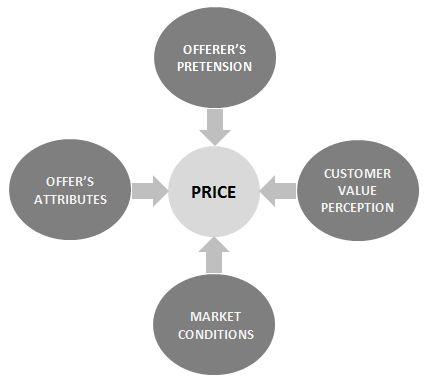Many forces affect the price of a sales object. All price managers must understand them to decide which prices to charge better.
In our approach, the forces acting on the price are called price vectors and sorted as offer’s attributes, offerer’s pretension, market conditions, and value perception, as shown in the diagram below.
 Offer’s attributes
Offer’s attributes
The first and crucial vector directing the price of an offer is its attributes. Offer attributes are the characteristics that define, qualify, and distinguish a product or service from others.
As for their inherence, the offer attributes of a sales object can be intrinsic and extrinsic; its tangibility, tangible and intangible; its immanence, of use and signaling; and its perception, perceived and unperceived.
Offerer’s pretension
The second vector driving the price is the offerer’s pretension.
To meet that pretension, the price manager must weigh (a) the business’s expected performance, (b) its operating conditions, and (c) the internal circumstantial pressures.
Market conditions
No matter how many attributes the offered product possesses and how plausible the offerer’s pretension may be, the proposed prices will only achieve their objectives with favorable market conditions.
It comprises the subsets supply behavior, demand behavior, competitors’ action, access to offer, and business environment.
Customer perceived value
The customer perceived value is the fourth and no less significant price vector.
For pricing, the offer value perceived by the customer is the monetary expression of the relative usefulness of something to those who purchase or intend to purchase it.
Each of these vectors drives the offer price with a certain intensity and direction, and the acting of all of them defines it.
C. L. Eckhard, author of Pricing in Agribusiness: setting and managing prices for better sales margins.











 Claudio Luiz Eckhard is a former professor, business consultant, and author of the books “Ajustando o Rumo”[Adjusting the Business Course], “Gestão pela Margem”[Management by Margin], “A Empresa Saudável”[The Healthy Company], and “Pricing no Agribusiness”[Pricing in Agribusiness].
Claudio Luiz Eckhard is a former professor, business consultant, and author of the books “Ajustando o Rumo”[Adjusting the Business Course], “Gestão pela Margem”[Management by Margin], “A Empresa Saudável”[The Healthy Company], and “Pricing no Agribusiness”[Pricing in Agribusiness].


